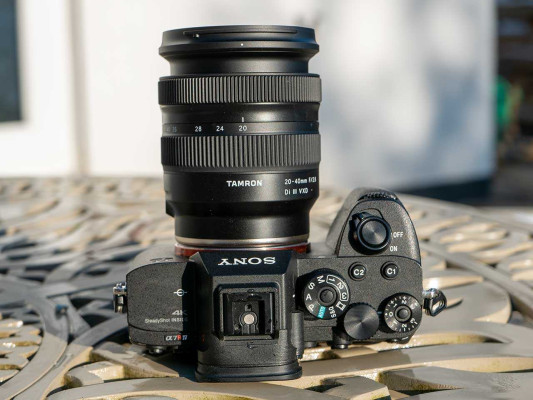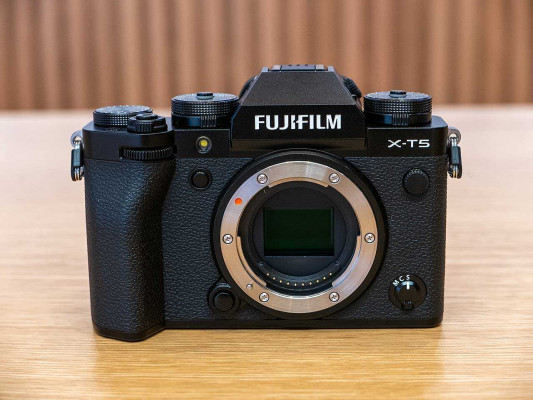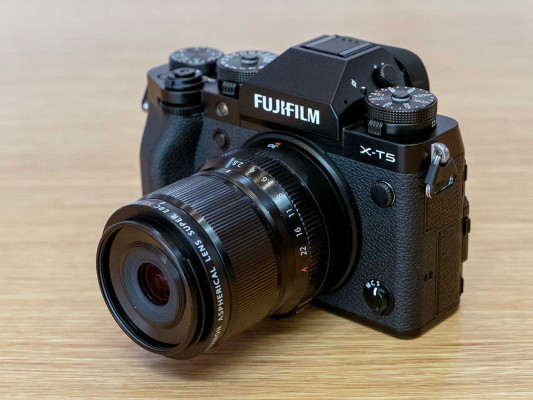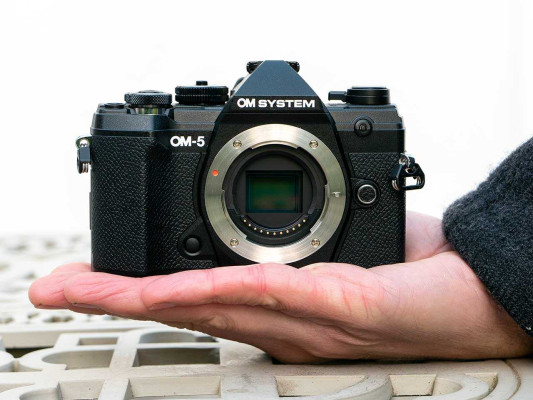Reviews

Great Joy 85mm 1.8x anamorphic mini-review
DPReview LatestAnother affordable anamorphic
 |
The Great Joy 85mm T2.9 1.8x anamorphic lens is the fourth anamorphic lens from this relatively new optical company. It joins the existing Great Joy 35mm T2.9 and 50mm T2.9 1.8x that both offer almost-full-frame coverage, as well as the 60mm T2.9 1.33x lens. The lens is available for EF, PL, E, L and MFT mounts.
Great Joy is offering amber flare, blue flare and ‘no-flare’ options of this 85mm, so users will be able to choose the profile they prefer. In contrast to other anamorphic lens makers, Great Joy has differentiated itself by making moderate design choices with subtle flare.
The angle of view you get from this lens depends a great deal on how you choose to use it. Technically the angle of view we associate with an 85mm focal length remains in place for the vertical aspect of the image, but the 1.8x anamorphic effect will widen the horizontal view to something like that which we’d expect from a 47mm lens. If you're using an APS-C or Super 35-sized recording area, the vertical view becomes like a 125.5mm lens and the horizontal view like that of a 70.5mm. On a Micro Four Thirds camera the effects are roughly equivalent to 170mm vertically and 94mm horizontally. Your mileage may vary, depending on what effect you're hoping to achieve.
For this mini-review I used the lens on the full-frame Panasonic Lumix S1H and S1R, and the Micro Four Thirds Lumix GH6.
If you would like to know more about shooting with anamorphic lenses and how they work see our article How Does Anamorphic Photography Work?
Sensor Coverage
 |
Compared to previous Great Joy lenses, this new model has improved sensor coverage characteristics.
Great Joy quotes the coverage as 36x24mm, which makes the lens much better for stills photography and also means that full-frame cameras can record video from the whole sensor. With a 3:2 full-frame sensor that can record ‘open gate’ we’ll get a 2.7:1 image once the footage is desqueezed. This can be used to make an expansive 2.66:1 frame that invokes CinemaScope movies, and gives you cropping and panning room when using a regular 2.39:1 timeline.
Vignetting is so minor in this lens when shooting full-frame that no one will notice except in the most technically critical situations. All of this is great news for full frame shooters, but if you're hoping to use the Great Joy anamorphic lenses as a set, the less-than-full-frame coverage of the 50mm and 35mm makes the 85mm the odd man out.
Exterior Design
 |
The lens housing is very much in keeping with the exterior style of the previous 35mm and 50mm lenses. It features a full metal barrel with cut-out sections to show us distance measurements in feet as well as meters, and iris markings on both sides of the lens. All the markings on the barrel, including the logo, are engraved into the metal and filled with white or orange paint, so there’s no danger of them rubbing off.
Both aperture and focus rings are equipped with 0.8 pitch mod gears for follow-focus kit. The version I reviewed was fitted for PL-mount cameras, so the gold ring you can see below is part of the Fotodiox adapter that allows the lens to be mounted on a Micro Four Thirds camera. I've used a Y-shaped lens support but the barrel has three mounting threads on the underside for screw-in posts and for mounting it directly to a tripod. The lens isn't so front heavy that it's likely to damage your camera mount if you use it unsupported. I shot with it without a rig at all on the Lumix S1R.
From the front
 |
From the front view the design doesn’t offer the usual clues that it is an anamorphic lens, as there is no rectangular baffle or forward-mounted anamorphic element. The significance of this design is that an all-seeing wide-viewed anamorphic cylindrical element at the forward end of an optical construction will pick up flare and stray light much more easily and will exaggerate the flare and streaks that are ‘characteristic’ of anamorphic cinema. Its lack means that these effects will be minimized; indeed, the new 85mm comes with an option for ‘no flare’ should you prefer less dynamic character.
Back end
 |
Great Joy presents us with another new optical design and layout of the anamorphic elements in this lens. In the 50mm (right) all the anamorphic bits were right at the front of the construction, while in the 35mm (left) it seems the engineers divided the anamorphic effect between groups of elements to either side of the aperture.
In this 85mm model (center) the rectangular shape of the housing for the exit elements suggests there are anamorphic groups, but when you look through the lens from the rear the iris appears round instead of oval – so these seem to be regular spherical elements. On closer inspection with a torch, I found an oval aperture visible behind the iris, which may be being used to accentuate the oval out-of-focus highlights. Viewing the iris from the front tells us that the anamorphic elements of the design are in front of the aperture – so the final effect comes from a joint effort either side of the main iris.
Mounting characteristics
 |
The PL mount version of the lens (shown in the sample photos) costs slightly more but is easily adaptable to a wide range of camera fittings. While the rear element protrudes into the adapter somewhat, it doesn't stick out from mount as far as the rear elements of the previous Great Joy lenses, with enough room for rear ND filters.
The PL model comes with an EF mount in the box so users can switch between PL and EF as they please. The mount comes with spare screws, and shims to calibrate the focus.
The mount is solidly made and clearly designed to support the weight of the lens without flexing. The PL version fit easily into my adapters and held the lens securely in place without any wiggling around.
Physical
 |
This is a relatively big lens with a fixed length of 132mm. The 18 elements, in 15 groups, coupled with the all-metal barrel adds up to a weight of 1.18kg (2.6 lbs) for the PL mount version. The filter thread is 82mm in diameter while the maximum outer diameter of the matte box end of the barrel is 85mm.
Remarkably the iris uses 16 blades, creating a noticeably rounder aperture than the 11 blades of the 35mm and 50mm lenses. This promises a smoother outline shape on the rendering of out-of-focus highlights.
The minimum focus distance marked is 0.7m (2.3ft), but the focus ring passes this point and my sample could focus to 0.67m.
Rings
 |
It takes a 238° rotation of the focus ring to take us from the closest to the furthest points available, which is slightly shorter than the rotation needed on the previous models – so follow-focus calibration might be needed if you have marked end points with the other lenses. The iris rotates through 84.3° to take us from T2.9 to T22. On the aperture scale the wider apertures are given much more space, while those from T11 to T22 are a little bunched up – the markings on the 35mm and 50mm are much more even.
The focus scale is also more closely bunched at the long end, which I suppose gives us more room for minor adjustments in the close-up range where we’ll need them more. On more expensive lenses you'll find aperture and focus markings more evenly spaced.
The focus ring turns smoothly and is nice turned either by hand or by manual/wireless follow-focus kits, while the aperture ring has enough tension that it is just hard enough to turn by accident. If working the focus ring manually you may need to be careful of the metal-on-metal clash at either extreme if your mic is close to the camera: the hard stops aren't dampened.
Compared
 |
When placed alongside the other two lenses in the series the 85mm blends in just as it should. The lenses follow the same design pattern and have their focus and iris rings in the same places so switching focal lengths doesn't also mean shifting focus gears. The 85mm is a little longer than the other two so matte box supports may need to be moved, but considering the focal length differences they are very close in physical dimensions.
The first Great Joy lens, the 60mm T2.9, also follows the same positioning for control rings, but the lens has a 1.33x anamorphic factor and needs the 1.35x adapter to make it match the 1.8x anamorphic factor of the 35mm, 50mm and 85mm – so then the focus ring on the lens is relevant as focusing is controlled via the adapter. The 60mm now feels a bit of a lone operator, and is slightly awkward within the lineup – not impossible to use, just a bit inconvenient.
Flare
 |
Great Joy is producing three versions of this lens, each with different flare characteristics, including the aforementioned ‘no flare’ option. I’m not certain whether ‘no’ refers to an avoidance of flare entirely or flare with no color. My sample had cool flare, but in line with the previous Great Joy anamorphic lenses the flare was moderate and needed deliberate action to be induced.
The 85mm can pick up a bit from a wider field beyond its angle of view than the 35mm, but the blue streaks won’t appear until the light source is actually in the frame or the light hits the front element from a shallow angle.
As with the 35mm, bright lights in the frame often produce a starburst effect even at wide apertures, and when lights are pointing into the camera streaks of flare will burst vertically as well as horizontally – as in the top sample above. This is quite an unusual effect for an anamorphic lens, but it isn’t unattractive.
Out-of-focus highlights
 |
Out-of-focus highlights appear as vertical ovals, as most people will expect from an anamorphic lens. They are reasonably long and distorted, and are more than sufficient to create the right ‘cat's eye’ impression. Obviously, you need to be focusing on something very close using a wide aperture, with the highlights way off in the distance, to make the most of the effect.
When you have large out-of-focus highlights you may notice that those closest to the edges of the frame begin to get a little out of shape, as they take on a sort of dent on the side facing the center of the picture. As you then compare the edge highlights with those in the middle it becomes obvious that this misshapen rendering afflicts highlights all across the frame – it’s just much less obvious in the middle.
Highlights are clean, though, with the ovals showing no distracting lines or patterns, and other than the dents that show up when they are big the effect is quite pleasant.
In daylight and conditions without hard light sources in the background, the rendering of out-of-focus areas behind the subject works very nicely to pop the focused areas forward in the frame. The way the lens distorts out-of-focus areas gives us an exaggerated sense of a shallow depth-of-field, which is one of the more important characteristics of an anamorphic lens: to isolate the subject.
Distortion and sharpness
 |
Great Joy lenses seem to have a preference for pincushion distortion in the vertical aspect, while displaying barreling in the horizontals that sit close the edges of the frame. This a characteristic that is common across the three lenses, so I guess it is part of a unifying look.
The impact of the pincushion effect will be determined somewhat by the size of the imaging area you are using. If you are shooting with the full width of the sensor you should expect to find pretty curved vertical lines close to the extremes of the frame, and even if you're cropping to a 2.39:1 frame (shown above in red) in post-production you’ll find a good deal of the distortion will remain. The slight barreling along the top and bottom of the frame is present whatever aspect ratio you choose, but it is quite moderate and won’t take over.
How you regard the sharpness of the lens will depend on what you record on and the resolution of your presentation. To make the lens work hard I started off shooting on the 47MP Lumix S1R, and found that when you look too closely you can definitely see the resolution limit of the optical system when the lens is used wide open, as images look soft as you'd expect. Stop down to just T4 and the lens becomes significantly sharper.
However, when the 15,000-pixel horizontal of the desqueezed images was resized to 8K resolution the lens looks nicely sharp – so if you output your films in 8K, 6K, 4K or 2K, they will look great.
I shot a lot of very low-light stills for this test, which highlighted another issue – not so much to do with this lens but high ISO shooting with anamorphics generally. Image noise generated by high ISOs becomes exaggerated when images are stretched/desqueezed – noise that doesn’t look too bad with a regular lens can become more noticeable. Obviously the greater the anamorphic factor of the lens, the more the noise will get enlarged.
Constant squeeze
 |
Great Joy claims this 85mm lens has a constant squeeze factor, meaning that the 1.8x anamorphic effect is maintained at all focus distances. This is useful, as it means that when you rack focus from one distance to another the subject in the desqueezed footage doesn’t change shape. The usual problem is that the squeeze factor drops at close distances and when those shots are desqueezed faces look wider than they should – which is rarely a good thing.
A basic test for this is to shoot a square target at close distance and desqueeze by the prescribed factor; if the square still is a square the factor is correct. And with this lens it is, which is a strong selling point. It is also notable that the close focus of this lens is 0.7 meters, which is quite impressive for an anamorphic lens and which means that we won’t have to use accessory diopter lenses to get close up, as we do with many other anamorphics.
The company’s 35mm (left in the picture above) also has a constant squeeze, while the 50mm (right) doesn’t. You can see here too how the front elements and baffles of these lenses are so different. The 50mm on the right is much more like the Sirui lenses with this rectangular baffle, while the newer two are more like spherical lenses at first glance. You can also see the shape of the iris in each lens (set to T5.6 for this picture) and how the 16 blades of the 85mm show quite differently to the 11 blades of the 50mm. I suspect that the 50mm will be redesigned at some stage.
Conclusion and pricing
 |
I’m a big fan of photographic equipment that enables more people to shoot more things, but which does it in a way that doesn’t make us compromise the quality of our image too much. This lens isn’t of Cooke or Panavision quality, but neither does it cost $30,000 – it will help open the door for more filmmakers to experiment with anamorphic lenses. This lens, along with the 50mm and 35mm, presents a very good kit for those looking to shoot anamorphic footage or stills, and the characteristics of the set match enough that they will look like they belong together too. They won’t give you the dramatic flare you can get elsewhere, sticking to a more moderate look. But then flare can be created with lens filters, and is much easier to add than to take away.
The Great Joy 85mm T2.9 1.8x is a nice lens: it's well made and it's very good at delivering a particular look to an image. It's easy to use, and comes at a price unimaginable only five years ago, coming in at $1500, which is just under the Sirui 75mm full frame lens that also has a maximum aperture of T2.9. The main differences are that the Sirui has a 1.6x anamorphic factor, doesn’t come in a PL or EF mount option, doesn’t focus as closely, is heavier and has 11 blades in its iris instead of 16. However, the Sirui model will deliver much more noticeable flare, and Sirui has a total of four matched lenses in its full-frame line-up rather than just three – and they do all actually fully cover a full-frame sensor whereas this is the only Great Joy lens that truly does that.
Price
The Great Joy 85mm T2.9 1.8x anamorphic lens is being launched via an Indiegogo campaign, and prices start at $1230 for the E/RF/MRT/L mount version and $1495 for the PL/EF version. After the campaign prices will be $1399/$1699.
For more information see the Great Joy website.
Note/disclaimer: Remember to do your research with any crowdfunding project before backing it. Pledges to crowdfunding campaigns are not pre-orders. DPReview does not have a relationship with this, or any such campaign, and we publicize only projects that appear legitimate, and which we consider will be of genuine interest to our readers. You can read more about the safeguards Indiegogo has in place on its 'Trust & Safety' page.

























